


L'origine des boîtes à musique peut être tracée à 1796, à Antoine Favre, l'horloger de Genève. Tout d'abord simplement un instrument incorporé dans les montres, les bouteilles de parfum, les pendants, etc., le mouvement musical, la boîte à musique devenu populaire pendant les décennies suivantes.
Lorsque cette activité industrielle a représenté 10% de tout le volume d'exportations suisses et était une source de plaisir à les personnes importantes de ce monde, de l'Europe vers la Chine.
Edison et son phonographe, la première guerre mondiale, aussi bien que la crise de 1928, ont frappé l'industrie de boîte à musique très sévèrement, tellement qu'elle a presque disparu. Après la deuxième guerre mondiale, grâce à l'armée américaine postée en Europe, les boîtes à musique suisses sont devenues populaires de nouveau comme souvenir ou présent spécial.
En 1960, une compagnie japonais a commencé à fabriquer en série de petits mouvements, concurrençant les environ trentes manufactures suisses. Plus tard, les chinois ont commencés à fabriquer de mouvements.
En conséquence, la plupart des compagnies suisses ont arrêté la fabrication, car les coûts en Asie sont une fraction de ceux en Suisse. Malheureusement, ceci a également eu comme conséquence une réduction des airs disponibles pour les clients.
Aujourd'hui, la manufacture suisse "Reuge" est la seule compagnie qui offre tous les tailles et styles de boîtes à musique.

Cette invention remonte à la fin du 19ème siècle et a annoncé l'arrivée du phonographe.
Les mouvements de disque sont très faciles à utiliser et facilitent l'établissement d'une bibliothèque des airs. C'est l'avantage comparé aux versions avec un cylindre.
En 1986, Reuge (Suisse) a acheté la production de mouvements de disque de la compagnie Thorens, un nom bien connu dans le monde entier. En 2010, Reuge a discontinué la production des boîtes à musique de disque.
Nous vendons des disques et des boîtes à musique de disque de la taille la plus commune - AD30 - qui est affiché au bas de >cette page.
Boîtes à musique avec un cylindre sont plus commun que les boîtes de disque.
Dans le texte suivant aussi bien que sur nos pages Web nous utilisons des abréviations pour décrire les mouvements. Un mouvement avec 1 chanson et 36 notes est abrégé 1.36.
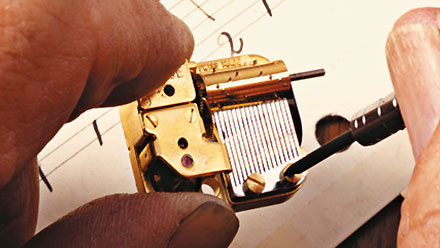
-- VERSION ANGLAIS, FRANCAIS EN TRADUCTION -- The smallest movements with 1 song 17 notes (1.17) on a cylinder are used for Musical Pocket Watches and Miniature Musicboxes.
The next size is 1.18, which is used often in small Music Boxes and in Jewellery Boxes. Although it has only one note more than the movement designed for Clocks, it is considerably bigger but much cheaper, as the miniaturisation of the smallest movement is difficult to achieve.
There are other movement sizes like the 1.28, which is also mostly used in Jewellery Boxes.
1.36 movements are used in "better" Jewellery Boxes as well as in Music Boxes without Jewellery compartment.
1.50 movements are available mostly in Music Boxes.
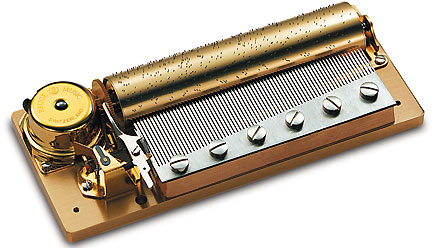
On the changing movement, a terrific technology, a mechanism moves the cylinder laterally, allowing others pins to be in front of the teeth comb in order to play the next tune. When every tunes played, the cylinder comes automatically back at the beginning. Most common is the 3.72 movement, which is adored by Music Box lovers all over the world. 3.144 movements contain two specially tuned 3.72 combs assembled side by side.

Cartel Music Boxes are more complicated in their construction than the above mentioned movements. Medium and big sized antique musicboxes often have this Cartel mechanism to wind up the movement. Cartel Boxes do not have a key underneath to wind up the spring, but a ratchet wind lever. The mainspring is not housed in a static springmotor, but in a rotating, cylinder-shaped spring barrel housing. The "butterfly" air brake is more intricate than those used in other movements.
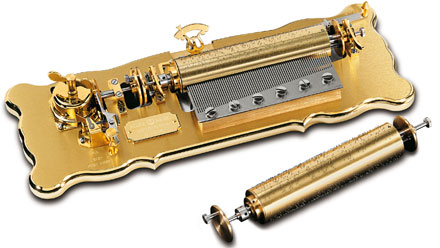
Interchangeable movements are constructed so that you can change between the five rolls that come with the box. It is not possible to buy later additional rolls. As with the other cylinder musicboxes, one has to decide before the purchase of the box what songs should come with the box (often 2 different sets are available).
Common sizes are 5.50 (5 cylinders with 1 song each) and 15.72 (5 cylinders with 3 songs each). Very extraordinary boxes, for example with 20 tunes 144 notes, are also available, but will cost accordingly and are often produced in a Limited Edition.
Arranging the tune(s): This step is only necessary when a new tune/tuneset is created for a musical movmenet. Each tune has to be condensed to its most characteristic part, so that it can be played and identified in 17, 24, 36 or 50 seconds, depending on the dimensions of the movement. The arrangement is made by a professional musician.
Machining: Shaping of the brass base-plates, on numerically controlled machines.
Stamping: Numerous stamping operations create mechanical parts that make up the movement, from materials such as brass or steel.
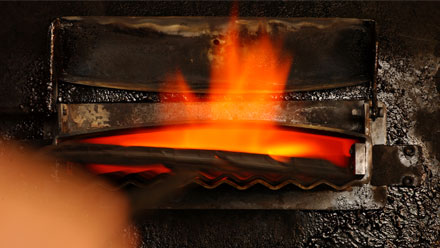
The comb: The combs are first of all cut rough, and then the teeth are cut by machines which were created, developed and made by Reuge. The comb is then heated and plunged into oil to create a thermal shock; the correct hardness of the comb, and therefore the correct tone is thus obtained. The temperature and the time of heat treatment that make Reuge’s quality and reputation, are kept secret. After that, lead is soldered underneath the teeth for the bass notes.
The comb is then tuned. This is a computerized operation; each tooth has a frequency, and a grinding wheel files them to the correct frequency.
Finally, dampers are glued underneath the teeth which produce the bass notes to act as a damper (to perfect the sound).

The cylinder: The brass cylinder is drilled by machines. After that, 0.25 mm diameter steel wire is inserted into the holes by other machines. At the factory "Reuge", each cylinder is visually checked to make sure that all the pins are in place and that they are straight. A small tool called a "poussette" (pusher) is used to insert the missing pins or to straighten ones which are crooked. Plugs are then placed at each end of the cylinder and an axle is placed inside. The next stage is equalizing the pins.
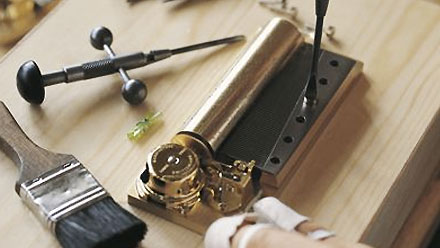
Fixing: This is the first time in the manufacturing of the musical movement when we can actually hear a tune. The fixer assembles all of the components on to the base-plate and checks the movement. The last step of the process is fixing the comb, so that it is exactly opposite the pins and neither too far nor too close to the cylinder, and checking the quality of the completed movement. This job requires a good musical ear and perfect vision.
The boxes are not manufactured in the same factories as the musical movements.
The inner sides are often made in elm, a very stable wood. Then the elm is covered with a precious wood: natural, colored or tinted.
The bottom is in a certain way the loudspeaker of the music box. It should be thin enough to vibrate well, as a violin, but thick and solid enough to bear the weight of the musical movement, as well as during the shipment.
The lacquer is made by 1 to 3 layers for 18- and 36-note boxes. For the deluxe boxes, more than 20 layers are applied. Between the layers, 3 to 4 days are necessary for drying. Polishing and cleaning are the last steps before applying the next layer.
There are also boxes made of other materials than wood, such as crystal glass, ceramic, plexiglass, and combinations of it.
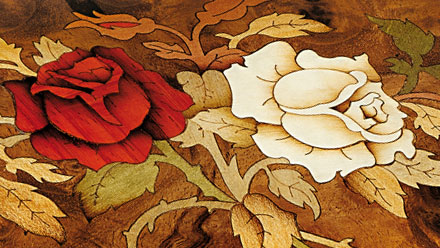
Inlay boxes: Many musicboxes are decorated with inlaid work, which is mostly hand-made. Sometimes, more than 100 species can be used and a design is made of 500 different pieces of wood. After the cutting, the pieces are assembled together on a sheet of paper, then stuck on the box. The paper is taken off by polishing.
The shadows in the inlays are achieved by burning the wood, piece by piece, in jars filled with hot sand.
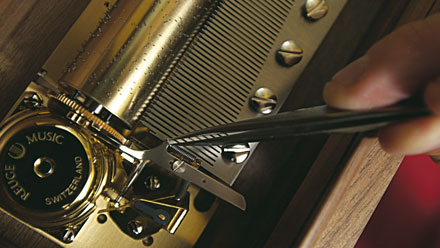
The movement is assembled with the case completely by hand.
After the movement is screwed into the box, the starter system is checked and adjusted.
The song label and winding key are added, and finally the finished product undergoes a quality control.
-- VERSION ANGLAIS, FRANCAIS EN TRADUCTION -- To get the best listening experience, keep the music box minimum 30 cm (12 inches) away from the ear and keep the glass lid closed.
You can vary the volume and tone of the sound by opening/closing the lid and the drawer (only some models with interchangeable rolls). Another factor is the surface on which the box is standing. Generally speaking, wood surface is good, but you have to try for yourself in your home where it sounds best.
-- VERSION ANGLAIS, FRANCAIS EN TRADUCTION -- Please do not wind a box while playing, wait till the tune stops.
When you wind the movement, stop as soon as you feel the slightest resistance, never force it.
Do not expose a music box to sunlight, look after your music box as you do with a furniture.
In hot and humid countries, if possible keep your box in an airconditioned room.
Protect the movement from dust by keeping the box closed or by lowering the protective glass cover when you play it.
It is best for the movement when it is stored mostly wound-down. If the musicbox is stored for a longer period fully wound-up, the steel spring that powers the mechanism may loose its tension.
For the carriage of boxes, make sure that the movement has stopped at the end of the tune. This way the pins of the cylinder do not touch the comb, and therefore can not damage anything.
For the box and musical movement, do not use any cleaning product which could damage it.
Do not touch the movement (especially the comb). However, if you do, take care to remove the fingerprints immediately with a dry cloth.
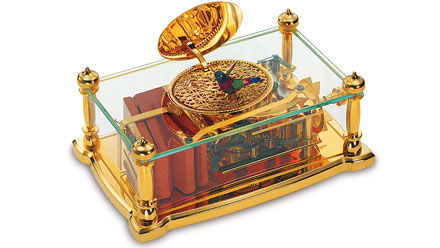
-- VERSION ANGLAIS, FRANCAIS EN TRADUCTION -- Approximately 10 years before the birth of mechanical music, Messrs. Jaquet-Droz of La Chaux-de-Fonds (Switzerland), manufacturers of complex clocks, perfected a singing bird automaton and miniaturised its movement, which they subsequently incorporated in their high-class clocks. It is this extraordinary mechanism, with its bellows and piston whistle, which imitates bird-song so beautifully.
In the 19th century, singing birds were very popular in China. It is said that the Chinese lords used them to teach real birds how to sing! At the time, singing bird competitions were a common occurence, even in Europe.
The technique was transferred to Reuge by the Bontems company in Paris, established in 1840, and by Eschle in Germany. These enterprises were purchased by Reuge in the 1960s in order to safeguard the tradition and to be able to offer you exquisite examples of this extraordinary art.